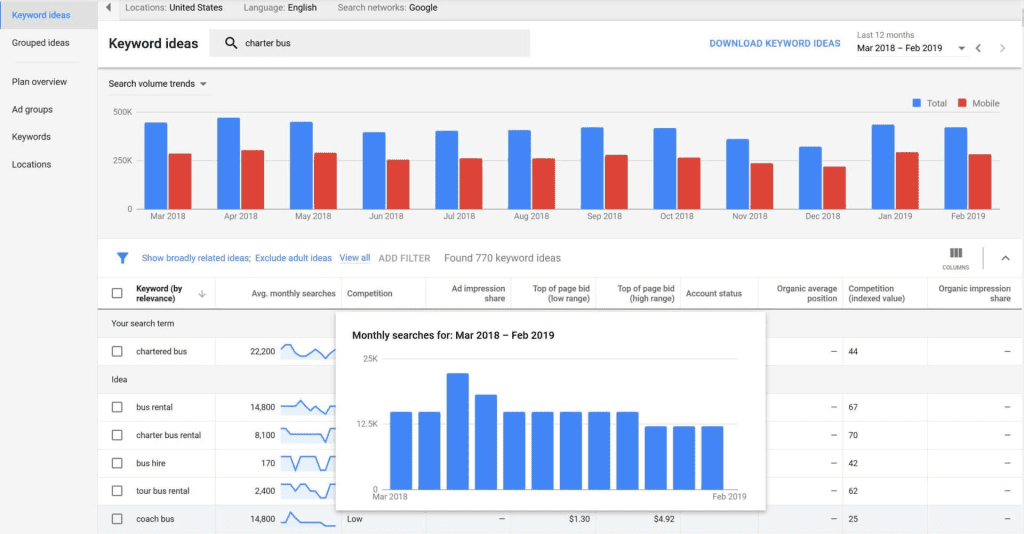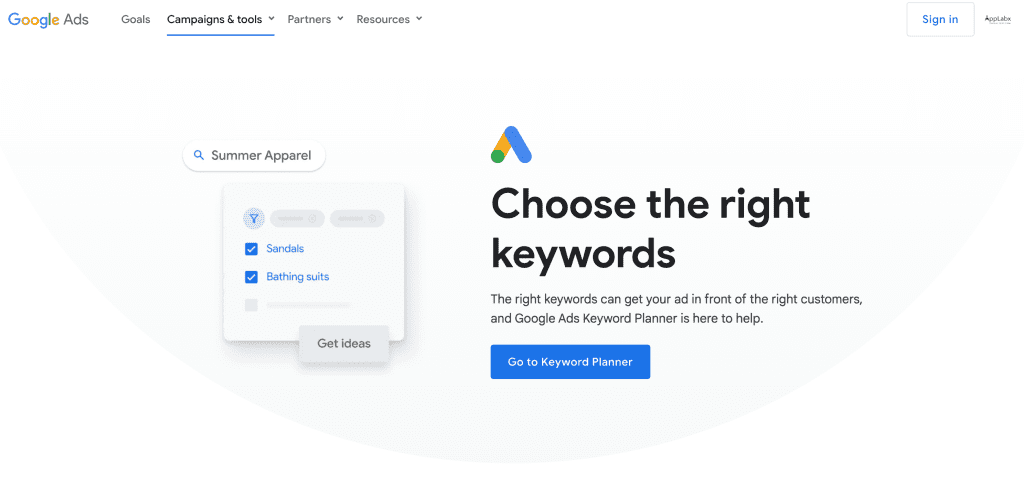Key Takeaways
- Strategic SEO Foundation: Google Keyword Planner is the bedrock of strategic SEO, empowering users to align content with user intent for enhanced online visibility.
- Precision in Keyword Selection: Learn to identify, analyze, and leverage keywords effectively. Explore search volumes, competition, and long-tail keywords for targeted impact.
- Adaptation for Future Trends: Stay ahead in the dynamic SEO landscape by understanding potential shifts, embracing new trends, and proactively refining keyword strategies.
In the dynamic realm of online presence, where visibility is the key to success, navigating the intricacies of Search Engine Optimization (SEO) demands more than just a cursory understanding of keywords—it requires a strategic approach.
As the digital landscape evolves, mastering the art of keyword selection becomes paramount, and at the heart of this mastery lies a powerful tool: Google Keyword Planner.

In this definitive guide, we embark on a journey into the realm of Google Keyword Planner, dissecting its inner workings and unraveling the secrets that can elevate your online presence.
Whether you’re a seasoned SEO expert or a novice entrepreneur looking to enhance your digital footprint, understanding the nuances of this indispensable tool is the gateway to unlocking the full potential of your online content.
Buckle up as we embark on this illuminating journey through the corridors of Google Keyword Planner—a journey that promises to transform your approach to SEO, empower your digital endeavors, and elevate your online presence to unprecedented heights.
Welcome to the gateway of precision—welcome to the realm of Google Keyword Planner.
But, before we venture further, we like to share who we are and what we do.
About AppLabx
From developing a solid marketing plan to creating compelling content, optimizing for search engines, leveraging social media, and utilizing paid advertising, AppLabx offers a comprehensive suite of digital marketing services designed to drive growth and profitability for your business.
AppLabx is well known for helping companies and startups use keyword research to drive web traffic to their websites and web apps.
At AppLabx, we understand that no two businesses are alike. That’s why we take a personalized approach to every project, working closely with our clients to understand their unique needs and goals, and developing customized strategies to help them achieve success.
If you need a digital consultation, then send in an inquiry here.
What is Google Keyword Planner? And How to Use It?
- Understanding Google Keyword Planner
- Why Use Google Keyword Planner?
- How to Set Up Google Keyword Planner
- Using Google Keyword Planner for Keyword Research
- Tips and Best Practices
- Future Trends and Updates
1. Understanding Google Keyword Planner
Google Keyword Planner, the cornerstone of effective keyword strategies, has undergone a transformative journey since its inception.
Initially introduced as part of Google AdWords, it has evolved into a multifaceted tool within the broader Google Ads ecosystem.

Key Features and Functionalities
Keyword Suggestions
Google Keyword Planner’s primary function is to provide users with an extensive array of keyword suggestions based on input parameters.
By entering relevant terms or phrases related to your niche or industry, the tool generates a comprehensive list of potential keywords.
For instance, if you’re in the fitness industry, entering “workout routines” could yield suggestions such as “exercises to lose belly fat,” “best exercise to lose weight,” and more.

Search Volume Data
Understanding the search volume for specific keywords is crucial for targeting the right audience.
Google Keyword Planner provides invaluable insights into how often users search for particular terms.
This data empowers marketers to prioritize high-volume keywords or strategically focus on niche, low-competition keywords based on their campaign objectives.
Competition Analysis
Assessing the competition for chosen keywords is pivotal in crafting a successful SEO strategy.
Google Keyword Planner categorizes competition into low, medium, and high, allowing users to identify keywords with the optimal balance of search volume and competition.
Example: If you’re in the e-commerce sector and find that the keyword “online clothing store” has high competition, you might explore alternatives like “boutique online clothing” with lower competition.
Understanding the Interface and Dashboard
Overview of the Dashboard
Upon entering Google Keyword Planner, users encounter an interface designed for efficiency and data clarity.
The dashboard typically includes sections for discovering new keywords, getting search volume data, and refining keyword lists.
Filters and Customization
One of the tool’s strengths lies in its flexibility.
Users can apply filters to tailor results based on geographic location, language, and search networks.
This customization ensures that the generated keyword suggestions align precisely with the intended target audience.
2. Why Use Google Keyword Planner?
Understanding the intrinsic connection between keywords and SEO success is foundational.
Keywords serve as the bridge connecting users’ search queries to relevant content, making them a pivotal element in search engine algorithms. 53.3% of website traffic globally comes from organic search, highlighting the paramount importance of effective keyword usage.

Benefits of Using Google Keyword Planner
Precision in Targeting
Google Keyword Planner empowers users to pinpoint keywords with surgical precision, ensuring that the content aligns seamlessly with user intent.
By accessing search volume data, marketers can identify keywords that resonate most with their target audience, leading to more qualified traffic.
Example: A business offering “sustainable fashion” can leverage Google Keyword Planner to discover related terms like “eco-friendly clothing” or “ethical fashion,” tailoring their content to meet the specific interests of environmentally conscious consumers.

Informed Decision-Making
Armed with comprehensive data on search volumes and competition levels, users can make informed decisions about which keywords to prioritize.
This strategic approach allows for the allocation of resources where they are most likely to yield maximum impact.
Cost-Efficient Advertising
For businesses engaging in paid advertising, Google Keyword Planner is a cost-effective tool for optimizing ad spend.
By identifying keywords with lower competition, advertisers can reduce their bid amounts while still reaching a highly targeted audience.
The average cost per click in Google Ads across all industries is $2.69 for search and $0.63 for display.
Strategic use of Google Keyword Planner can help businesses find keywords with lower CPC, maximizing their advertising budget.
Comparison with Other Keyword Research Tools
Google’s Search Data Advantage
One of the distinctive advantages of Google Keyword Planner is its direct access to Google’s search data.
This gives it a unique edge over third-party tools, providing users with real-time insights into the user behaviour of the world’s largest search engine.
While other tools may offer additional features, the direct integration with Google’s search data makes Google Keyword Planner an invaluable resource for understanding current search trends.
Seamless Integration with Google Ads
The seamless integration of Google Keyword Planner with Google Ads is a game-changer for advertisers.
The data obtained from the planner can be directly applied to Google Ads campaigns, streamlining the process of keyword selection and ad creation.
Example: If a business identifies a high-performing keyword in Google Keyword Planner, it can easily incorporate this insight into its Google Ads campaign, ensuring alignment between organic and paid strategies.
3. How to Set Up Google Keyword Planner

Creating a Google Ads Account
Before diving into the wealth of insights offered by Google Keyword Planner, the first crucial step is to establish a Google Ads account.
This platform not only acts as a gateway to the planner but also provides access to a suite of advertising tools.

Steps to Create a Google Ads Account
- Visit the Google Ads Homepage: Navigate to the Google Ads homepage (ads.google.com) and click on “Start Now.”
- Sign In or Create an Account: Sign in with your existing Google account or create a new one.
- Enter Business Information: Provide essential details about your business, including the website and business category.
- Set Up Billing: Follow the prompts to set up billing information. Google Ads often offers promotional credits for new advertisers, providing an initial budget to explore the functionalities of Google Keyword Planner.
Accessing Google Keyword Planner within Google Ads
With a Google Ads account in place, unlocking the potential of Google Keyword Planner is the next logical step.
Navigating to Keyword Planner
- Log in to Google Ads: Use your Google Ads credentials to log in to your account.
- Go to Tools & Settings: On the upper-right corner, click on the wrench icon to access the “Tools & Settings” menu.
- Select Keyword Planner: Under the “Planning” section, choose “Keyword Planner.”
Understanding the Keyword Planner Dashboard
Upon entering Google Keyword Planner, users encounter a user-friendly dashboard designed for efficient navigation and data extraction.
- Discover New Keywords: This section allows users to find new keywords by entering relevant terms or phrases. It provides a list of suggestions along with key metrics such as average monthly searches and competition.
- Get Search Volume Data and Forecasts: Users can input a list of keywords to retrieve valuable insights on search volume trends over time, helping in strategic planning.
- Refine Keyword Lists: This feature enables users to fine-tune their keyword lists based on specific criteria, including location, language, and search networks.
Leveraging Google Ads for Strategic Insights
Keyword Insights for Advertisers
For businesses engaging in paid advertising, the integration of Google Keyword Planner with Google Ads is a strategic advantage. The tool provides insights into keywords that can optimize ad spend, ensuring cost-efficient campaigns.
Example: If an online shoe store identifies “affordable running shoes” as a high-volume, low-competition keyword, it can incorporate this insight into its Google Ads campaign targeting budget-conscious runners.
Integrating SEO and Paid Strategies
The synergy between SEO and paid advertising is undeniable, and Google Keyword Planner acts as a unifying force. Keywords identified through the planner can seamlessly inform both organic content creation and paid ad campaigns.
4. Using Google Keyword Planner for Keyword Research

Finding Relevant Keywords for Your Niche
Inputting Seed Keywords
- Understand Your Niche: Before utilizing Google Keyword Planner, it’s essential to have a clear understanding of your niche. Identify the core themes and topics relevant to your business or content.
- Enter Seed Keywords: Start by entering seed keywords or phrases that encapsulate the essence of your niche. For example, if you’re in the travel industry, “adventure travel destinations” can be a compelling seed keyword.
Exploring Keyword Suggestions
- Evaluate Keyword Suggestions: Google Keyword Planner generates a plethora of keyword suggestions based on the seed input. Assess the relevance of these suggestions to your niche and audience.
- Example Scenario: If you’re running a blog on sustainable living, entering “green lifestyle” might yield suggestions like “zero waste living,” “eco-friendly products,” and “sustainable fashion.”
Analyzing Search Volume and Competition
Understanding Search Volume
- Identify High-Volume Keywords: Use Google Keyword Planner to uncover keywords with substantial search volume. This indicates the popularity of certain terms within your niche.
- Example: For a fitness blog, discovering that “home workouts” has a monthly search volume of 100,000 indicates a significant demand for content related to at-home exercise routines.
Assessing Competition Levels
- Low, Medium, or High Competition: Google Keyword Planner categorizes keywords based on their competition levels. Low-competition keywords are often easier to rank for but may have lower search volumes.
- Example Scenario: In the pet care industry, finding that “organic pet food” has low competition suggests an opportunity to target a specific audience with less fierce competition.
Identifying Long-Tail Keywords
Definition and Importance
- Long-Tail Keywords Explained: Long-tail keywords are longer and more specific phrases that cater to a niche audience. While they may have lower search volumes, they often boast higher conversion rates.
- Significance for SEO: Incorporating long-tail keywords into your content strategy can enhance relevance and target a more qualified audience, contributing to improved SEO performance.
Utilizing Long-Tail Keywords for Niche Markets
Example: In the technology sector, targeting “best budget-friendly gaming laptops under $1000” as a long-tail keyword can attract a specific audience looking for precise information, leading to higher engagement and conversions.
Tips for Efficient Keyword Selection
Align Keywords with Business Goals
- Define Your Objectives: Clearly outline your business or content goals. Whether it’s driving traffic, increasing sales, or building brand awareness, your keyword strategy should align with these objectives.
- Example: If your goal is to increase product sales for handmade jewellery, targeting keywords like “unique artisan jewellery” or “handcrafted gemstone necklaces” can attract potential buyers.
Refining Keyword Lists
- Regularly Review and Refine: The digital landscape is dynamic, and so are search trends. Regularly review and refine your keyword lists to stay relevant and capitalize on emerging opportunities.
- According to a study, updating and republishing old blog posts with new content and keywords can increase organic traffic by an average of 106%.
5. Tips and Best Practices

Optimizing Keyword Selection for Specific Goals
Define Clear Objectives
- Establish Business Goals: Clearly define your business or content objectives. Whether it’s boosting website traffic, generating leads, or increasing online sales, having a well-defined purpose will shape your keyword strategy.
- Example: If your objective is to enhance brand visibility for a digital marketing agency, focus on keywords like “effective online marketing strategies” or “ROI-driven digital campaigns.”
Tailor Keywords to User Intent
- Understand User Intent: Align your keywords with the intent behind users’ searches. Are they seeking information, looking to make a purchase, or exploring solutions to a problem?
- Example Scenario: For a blog on healthy recipes, targeting keywords like “quick and nutritious dinner ideas” caters to users with the intent of finding easy-to-prepare meals.
Refining Keyword Lists Based on Relevance
Regularly Review and Update
- Dynamic Keyword Landscape: The digital landscape evolves, and so do search trends. Regularly review and update your keyword lists to stay relevant and capitalize on emerging opportunities.
- Data Insight: According to HubSpot, it’s estimated Google processes approximately 99,000 search queries every second, translating to 8.5 billion searches per day. Staying attuned to evolving search patterns is essential for maintaining relevance.
Focus on Relevance Over Volume
- Quality Over Quantity: Prioritize relevance over sheer search volume. Targeting keywords that align closely with your content or product ensures higher engagement from the right audience.
- Example: If you operate a niche bookstore specializing in rare editions, targeting “collectible first edition books” might have a lower search volume but is highly relevant to your audience.
Utilizing Filters and Settings Effectively
Geographic and Language Filters
- Localized Targeting: If your business caters to specific regions, use geographic filters to tailor your keyword research to local audiences.
- Example Scenario: A coffee shop in Seattle can refine its keyword strategy by including location-specific terms like “best coffee in Seattle” or “local artisanal roasters.”
Device and Network Settings
- Optimize for Mobile: With the increasing prevalence of mobile searches, consider adjusting settings to prioritize keywords that resonate with users on mobile devices.
- As of the second quarter of 2023, around 95.8 per cent of global users accessed the internet via mobile phones, emphasizing the significance of mobile optimization.
Crafting Compelling and Click-Worthy Titles
Keyword Placement in Titles
- Strategic Title Structure: Integrate primary and secondary keywords naturally into your content titles. Search engines often prioritize titles when determining the relevance of content.
- Example: For a blog post on home gardening tips, a title like “Harvest Abundance: Essential Home Gardening Tips for a Flourishing Garden” incorporates relevant keywords seamlessly.
Engaging Meta Descriptions
- Compelling Descriptions: Craft meta descriptions that not only include keywords but also entice users to click. A well-written meta-description can significantly impact click-through rates.
- According to Backlinko, pages with a meta description have a 5.8% higher click-through rate than those without.
6. Future Trends and Updates

Potential Changes in Google Keyword Planner
Evolving Algorithm Updates
Dynamic Search Algorithms: Google’s search algorithms are continually evolving. Stay abreast of algorithm updates, as they can influence the performance of keywords and the effectiveness of your SEO strategy.
Integration of New Metrics
- Emerging Metrics: Keep an eye on potential additions to the metrics provided by Google Keyword Planner. As user behaviour evolves, new metrics may be introduced to better reflect the nuances of search trends.
- Example Scenario: Google may introduce metrics related to user intent, helping marketers understand not just what users are searching for, but why.
Adaptation Strategies for an Evolving SEO Landscape
Embrace Voice Search Optimization
- Rise of Voice Searches: With the growing prevalence of voice-activated devices, optimizing for voice search is becoming crucial. Consider incorporating conversational and long-tail keywords to align with voice search patterns.
- Forecasts suggest that by 2024, the number of digital voice assistants will reach 8.4 billion units – a number higher than the world’s population.
Video and Visual Search Optimization
- Visual Content’s Impact: As visual content gains prominence, optimizing for visual search becomes essential. Leverage descriptive keywords and image alt text to enhance visibility in visual search results.
- Example: An e-commerce site selling furniture can optimize for visual search by including descriptive keywords like “modern blue velvet sofa” in image alt text.
Proactive Keyword Planning for Emerging Trends
Stay Ahead of Industry Shifts
- Monitor Industry Trends: Actively monitor industry shifts and emerging trends. Align your keyword strategy with these changes to position your content or business as a relevant and authoritative source.
- A survey by HubSpot found that 61% of marketers stated that improving their SEO and growing their organic presence is their top inbound marketing priority.
Explore New and Niche Keywords
- Diversify Keyword Portfolio: Don’t solely rely on established keywords. Explore new and niche keywords that may emerge with evolving user interests and preferences.
- Example Scenario: In the tech industry, as interest in “green technology” grows, incorporating keywords like “eco-friendly gadgets” can capture a burgeoning audience.
Artificial Intelligence and Machine Learning Impact
AI-Driven Search Algorithms
- Google’s AI Evolution: Google increasingly incorporates artificial intelligence (AI) and machine learning into its search algorithms. Understand the implications of AI-driven search results and adapt your keyword strategy accordingly.
- Example Scenario: Google’s BERT algorithm, introduced in 2019, focuses on understanding context in search queries. Adapting to this, keywords should reflect user intent more accurately.
Personalized Search Experiences
- Personalization Algorithms: AI enables search engines to deliver personalized search experiences. Tailor your keyword strategy to accommodate personalized search results based on user preferences and behaviour.
- According to Think with Google, 63% of consumers surveyed across the U.S., Canada, and the U.K. expect personalization as a standard of service.
Conclusion
In the ever-expanding digital landscape where the quest for online visibility reigns supreme, the role of strategic keyword planning cannot be overstated.
As we conclude our comprehensive exploration of “What is Google Keyword Planner? And How to Use It,” it’s evident that this indispensable tool is not merely a facilitator of keyword research; it is the compass guiding businesses, marketers, and content creators toward the pinnacle of SEO success.
The Unveiling of Google Keyword Planner
In the journey through the intricate corridors of Google Keyword Planner, we embarked on a discovery of its evolution, functionalities, and the unparalleled insights it provides.
From its roots in Google AdWords to its current status as a linchpin in keyword strategies, the planner serves as a beacon for those navigating the vast ocean of digital content creation and promotion.
The Inextricable Link Between Keywords and SEO
Our exploration delved into the very foundation of effective SEO—keywords. We dissected the intricacies of keyword selection, understanding how it serves as the bridge connecting user intent to relevant content.
Unleashing the Power of Google Keyword Planner
Armed with the knowledge of Google Keyword Planner’s key features and functionalities, we ventured into the process of accessing and navigating this potent tool.
The creation of a Google Ads account emerged as the gateway to unlocking a world of strategic insights, empowering users to tailor their keyword strategies for optimal results.
Strategic Utilization for Maximum Impact
The heart of our exploration lies in the practical application of Google Keyword Planner for keyword research.
From finding relevant keywords for diverse niches to analyzing search volume and competition, we witnessed the precision with which this tool shapes effective SEO strategies.
The identification of long-tail keywords, often overlooked but immensely powerful, added a layer of depth to our understanding of user intent and engagement.
Best Practices and Future-Proofing Strategies
Guided by tips and best practices, we learned to optimize keyword selection based on specific goals, refine lists for relevance, and leverage filters effectively.
As we peered into the future, the anticipation of algorithm updates, the rise of voice and visual searches, and the omnipresence of AI and machine learning became the focal point.
We explored adaptation strategies, encouraging a proactive approach to keyword planning in an ever-evolving SEO landscape.
The Transformative Journey Continues
In conclusion, Google Keyword Planner is not a static tool; it is a dynamic force driving the evolution of digital visibility.
As we close this chapter, remember that the transformative journey does not end here—it is ongoing. The strategic use of Google Keyword Planner is not just about the present; it’s about staying ahead, anticipating shifts, and embracing the future of SEO.
So, let this serve as an invitation to wield the power of Google Keyword Planner with finesse, to adapt and innovate, and to witness the transformative impact on your online presence.
As you navigate the realms of SEO, armed with the insights gleaned from this exploration, may your journey be marked by visibility, engagement, and sustained success in the ever-expanding digital frontier.
The future of SEO beckons, and with Google Keyword Planner as your guide, the possibilities are boundless.
If you are looking for a top-class digital marketer, then book a free consultation slot here.
If you find this article useful, why not share it with your friends and business partners, and also leave a nice comment below?
We, at the AppLabx Research Team, strive to bring the latest and most meaningful data, guides, and statistics to your doorstep.
To get access to top-quality guides, click over to the AppLabx Blog.
People also ask
How do I use Google Key Planner?
To use Google Keyword Planner, start by accessing it within Google Ads. Set up a Google Ads account, navigate to “Tools & Settings,” and select “Keyword Planner.” Enter seed keywords, explore suggestions, analyze search volumes, and competition, and refine your strategy. Leverage its insights for precision in SEO and content creation.
Is Google Keyword Planner worth it?
Absolutely. Google Keyword Planner is an invaluable tool for SEO. It offers insights into keyword trends, search volumes, and competition, enabling precise targeting. Whether you’re a marketer, business owner, or content creator, it’s an indispensable resource for optimizing online visibility.
How do Google keywords work?
Google keywords work by connecting user searches with relevant content. Advertisers bid on keywords through Google Ads, and when users search using those terms, the ads or content with the highest bid and relevance appear. Google’s algorithm assesses quality and relevance, ensuring a seamless match between queries and results.


































